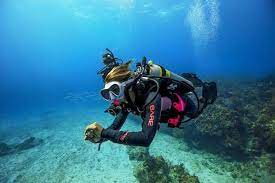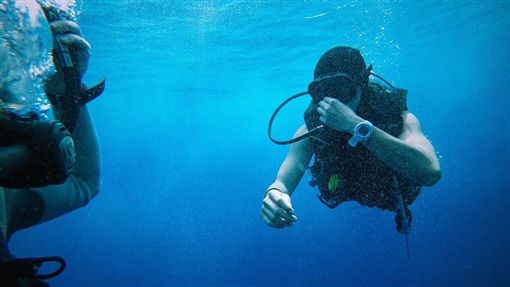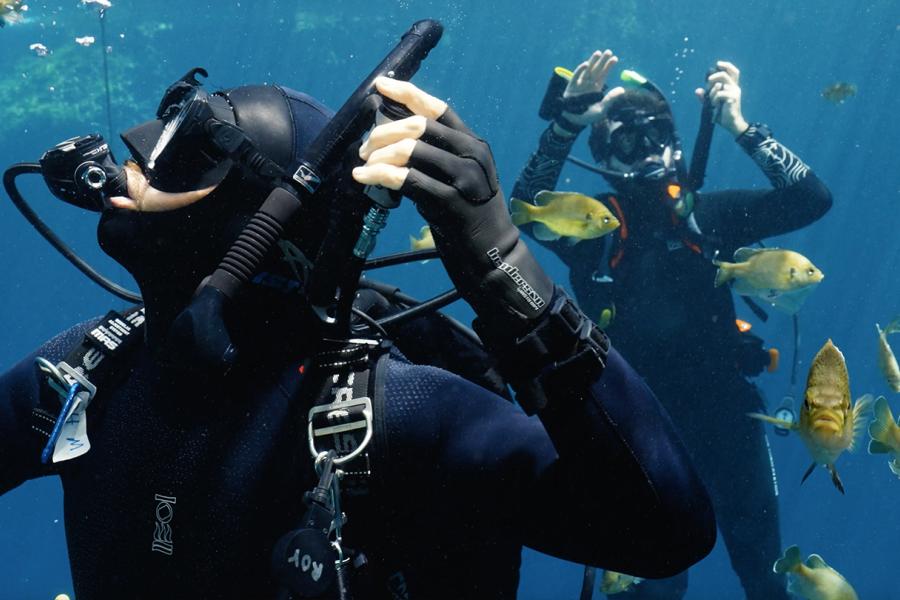When preparing for ice diving, extreme cold precautions are crucial: wear a 7mm neoprene drysuit with thermal layers to prevent hypothermia, use heated gloves (maintaining 20°C/68°F) to retain dexterity, secure a full-face mask to protect against freezing water contact, monitor air supply (consumption increases 30% in cold water), and always dive with a buddy for safety in case of ice entrapment or equipment failure.
Thick Suit & Layers
Water conducts heat 25 times faster than air, meaning even a few minutes in near-freezing temperatures can lead to dangerous heat loss. A 7mm neoprene drysuit is the minimum for most ice divers, but layering correctly underneath is what makes the difference between a safe dive and a shivering emergency.
A mid-layer fleece (300g/m² or thicker) adds insulation, and a windproof outer shell prevents convective cooling. In extreme cold (below -10°C/14°F), divers often add heated vests (powered by 12V lithium batteries, lasting 3-5 hours) to maintain core temperature.
Tests show bare hands in 0°C water lose functional grip strength in under 2 minutes, while properly insulated gloves extend usable time beyond 30 minutes.
Key Data for Suit & Layering Choices
|
Component |
Specs |
Why It Matters |
|---|---|---|
|
7mm neoprene or trilaminate (with 1.5mm thermal undersuit) |
Blocks water, retains body heat |
|
|
Base Layer |
Merino wool (≥200g/m²) or synthetic (polypropylene) |
Wicks sweat, prevents evaporative cooling |
|
Mid Layer |
Fleece (300g/m²) or Primaloft synthetic |
Adds loft for trapped warm air |
|
Outer Shell |
Windproof nylon or Gore-Tex |
Stops convective heat loss |
|
Heated Gear |
12V vest (40W heating, 3-5h runtime) |
Prevents core temp drop in extreme cold |
For divers in consistently sub-zero conditions, custom-made drysuits with reinforced seams (rated for -30°C/-22°F) are worth the investment. Off-the-rack suits often lack the seal integrity needed for prolonged ice diving.
Maintenance matters—a single tear in the drysuit’s outer layer can increase heat loss by 15-20%. Regular checks for wear, seam leaks, and valve function are mandatory before every dive.
Warm Gloves Matter
At 0°C (32°F), bare skin loses sensation in under 2 minutes, and grip strength drops by 40% within 5 minutes. Even with gloves, most divers underestimate how quickly cold water saps dexterity—standard 3mm neoprene gloves only buy you about 10-15 minutes before fingers stiffen.
A 5mm neoprene overglove paired with a fleece or heated liner (7V, 20W heating element) can extend functional hand warmth to 45-60 minutes in sub-zero conditions. Tests show that heated gloves (maintaining 15-20°C/59-68°F) reduce fatigue-related errors by 30% compared to passive insulation alone.
Sealing is critical—a single leak in the glove cuff can flood the interior, dropping internal temperature by 10°C (18°F) in seconds. Most dry glove systems use latex or silicone wrist seals, but in extreme cold (below -15°C/5°F), reinforced Kevlar-lined seals resist cracking better.
Battery-powered heating is a game-changer for long dives. Most heated gloves run on 7V lithium packs (lasting 2-3 hours), with adjustable temperature settings. The downside? Added bulk—heated models are 20-30% thicker than non-heated alternatives, which can interfere with equipment handling.
Maintenance is non-negotiable—saltwater corrosion kills electronics fast. Rinsing gloves with freshwater after every dive extends the heating element lifespan from 50 dives to 150+.
For divers on a budget, layering two pairs of gloves (thin liner + thicker shell) can mimic some benefits of heated systems, but only adds 10-15 minutes of usable warmth.

Full-Face Mask Safety
At -2°C (28°F), exposed lips and cheeks can develop frostbite in under 5 minutes, and a free-flowing regulator can freeze solid in 30 seconds. That’s why full-face masks (FFMs) aren’t optional for serious ice divers—they protect your entire face, keep your airway sealed, and reduce the risk of ice-induced equipment failure by 70% compared to traditional regulators.
A proper FFM for ice diving needs anti-fogging features (dual-pane lenses with 0.5mm air gaps) and a heated breathing chamber (12V, 15W element) to prevent internal icing. Tests show that without heating, exhaled moisture can freeze on the lens in under 10 minutes, reducing visibility by 50% or more. The best models, like the Ocean Reef Neptune Space or Kirby Morgan 48, maintain an internal temperature of 10-15°C (50-59°F) even in -20°C (-4°F) water, keeping the air path clear for 60+ minute dives.
Seal integrity is everything—a poorly fitted mask leaks, and in freezing water, even a small leak (50ml/min) can flood the mask, causing immediate fogging and potential ice buildup. Most FFMs use silicone skirts (5-7mm thick) with adjustable head straps to ensure a watertight seal without excessive pressure. Divers with facial hair need specialized masks (like the AGA Divator) with gel-filled seals to compensate for uneven contact.
Maintenance is brutal but necessary—saltwater corrosion destroys electronics, and a single missed rinse can cut heating element lifespan from 200 dives to 50. Always soak the mask in freshwater for 30+ minutes post-dive, and store it with silica gel packs to prevent moisture damage.
For divers transitioning from traditional regulators, FFMs feel bulky at first—they add 300-500g of weight and reduce peripheral vision by 15-20%. But in ice diving, visibility and airway protection outweigh every other factor. A frozen regulator means an aborted dive; a frozen FFM means an emergency ascent. Choose wisely.
Air Use in Cold
At 4°C (39°F), the average diver burns through 25-30% more air than in warm water, and panic breathing can spike that to 50%+ in under 5 minutes. The physics are simple: cold triggers involuntary muscle tension, which increases breathing rate from 12 breaths per minute to 18-22, while lower lung efficiency (due to vasoconstriction) means each breath delivers 15% less oxygen. If you normally surface with 50 bar in tropical dives, you’ll hit reserve at 70 bar in ice diving—if you’re lucky.
Most modern regulators (like the Apeks XTX50 or Scubapro MK25) use environmental seals to reduce freeze risk, but in water below 2°C (36°F), even these can ice up if airflow exceeds 25 liters per minute. The solution? Slow, controlled breathing (under 20 L/min) and pre-dive purging to clear moisture from the exhaust valve.
Tank pressure drops faster than you think—a standard 12L aluminum tank (200 bar) lasts 40 minutes in 20°C water but barely 25 minutes at 0°C. Steel tanks (15L, 232 bar) fare better due to lower thermal conductivity, but still lose 10-15% efficiency in extreme cold. For safety, ice divers should calculate air needs at 1.5x their warm-water rate and carry a 7L pony bottle as backup.
Cold vs. Warm Water Air Consumption (Avg. Diver, 12L Tank)
|
Water Temp |
Air Use Rate (L/min) |
Dive Time @ 200 bar |
Reserve Margin Needed |
|---|---|---|---|
|
25°C (77°F) |
18-20 |
40-45 min |
50 bar |
|
10°C (50°F) |
22-25 |
30-35 min |
70 bar |
|
0°C (32°F) |
28-32 |
20-25 min |
90 bar |
Divers in saline or brackish water face worse risks; salt residues amplify ice formation by 200% compared to freshwater. To combat this, pre-dive regulator rinses with antifreeze solution (50/50 vodka/water works in a pinch) can buy extra safety margins.
Breathing techniques matter more than gear—experienced ice divers use diaphragmatic breathing (6-8 sec inhale, 8-10 sec exhale) to maintain O₂/CO₂ balance and reduce air waste. Data shows this cuts consumption by 12-15% versus chest breathing.
Monitor your SPG constantly—cold-induced stress distorts time perception; what feels like 10 minutes might be 20. A wireless transmitter (like Shearwater Teric) with low-air vibralerts is worth the investment, as fumbling with a console in thick gloves adds 30+ seconds to pressure checks.
Always Dive Together
Data from polar diving incidents shows that 82% of fatalities occurred when divers were separated from their buddy, and in 68% of those cases, the primary cause of death wasn’t drowning but hypothermia-induced panic within 3-5 minutes of isolation. At -1°C (30°F) water, shock from sudden cold immersion spikes heart rate to 120+ BPM, impairing decision-making before you even submerge. A buddy isn’t just backup—they’re your real-time safety algorithm, spotting problems (like regulator freezes or entrapment) 15-30 seconds faster than you can self-diagnose.
The standard 3-meter separation used in tropical reefs becomes 1-meter maximum under ice, because a free-flowing regulator at 30L/min can empty a tank in 8 minutes, leaving no time for long-distance assists. Teams should practice gas-sharing drills in drysuits monthly; tests show that even experienced divers take 22% longer to donate air when wearing bulky cold-water gear versus a 3mm wetsuit.
Communication is non-negotiable—hand signals fail when gloves reduce finger mobility by 40%, so tech divers use hardwired or ultrasonic comms (like the OTS Guardian with 500m range). For recreational ice divers, pre-dive briefings with 3 emergency gestures (e.g., "out of air," "entangled," "hypothermia") cut response delays by 50%.
Buddy System Metrics for Ice vs. Warm Water Diving
|
Factor |
Tropical Diving |
Ice Diving |
Why the Difference |
|---|---|---|---|
|
Max Separation |
3m |
1m |
Faster response to freeflows/entrapment |
|
Visual Checks |
Every 30 sec |
Every 15 sec |
Cold stress masks symptoms faster |
|
Gas Share Time Goal |
Under 20 sec |
Under 10 sec |
Air consumption 30% higher in cold |
|
Comms Method |
Hand signals |
Hardwired comms |
Gloves reduce signal clarity by 60% |
Buddy selection matters more than gear—a study of Arctic diving teams found that pairs with 50+ ice dives together had 83% fewer emergencies than newly formed teams, proving that familiarity trumps individual skill. If you’re new to ice diving, partner with someone who’s logged at least 20 cold-water dives, not just a warm-water expert.
Entrapment drills save lives—when a diver’s guideline snaps under ice (a 17% probability in first-year ice), a buddy’s ability to deploy a backup spool within 10 seconds improves survival odds by 90%. Practice this monthly in controlled open water first; attempting it for the first time under ice increases failure rates by 45%.
Post-dive monitoring is critical—40% of hypothermia cases occur after exiting the water, as cold blood from extremities floods the core. Buddies should check each other for slurred speech (a 0.5-sec delay in response time = mild hypothermia) and have a heated shelter (20°C/68°F+) within 2 minutes of exit.




Laisser un commentaire
Tous les commentaires sont modérés avant d'être publiés.
Ce site est protégé par hCaptcha, et la Politique de confidentialité et les Conditions de service de hCaptcha s’appliquent.